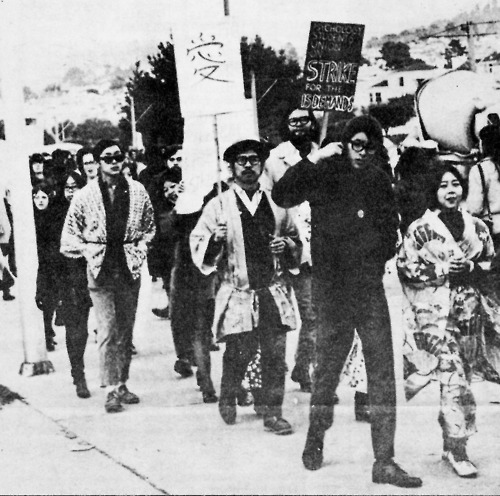1960s Yellow Power: The Origins of Asian America
Prior to the social and political upheavals of the 1960s, there was no “Asian America”—at least not as we know it today. While Americans of Asian descent had joined forces on the picket line and plantation field throughout history, their identities and struggles were mostly defined along distinct ethnic lines. But amidst the tumult of the civil rights movement, young people united their communities to forge a new identity based on their collective experiences as Asian Americans. - https://densho.org/catalyst/asian-american-movement/
The notion of Asian America was rooted in a pan-Asian identity that would harness the power of a “consolidated yellow people” against the forces of racism and imperialism. Inspired by the radical politics of the Black Liberation Movement and frustrated with white progressives’ failure to engage with race in a meaningful way, Asian Americans set out to create their own movement.
Yuji Ichioka, who taught the first Asian American studies class at UCLA, is credited with coining the term “Asian American” in 1968. He and his partner Emma Gee, then student activists at UC Berkeley, founded the Asian American Political Alliance out of their living room that summer, adopting the name to unify previously separate groups of ethnic Asian students—and to subvert the “Oriental” trope thrust on them by whites unable (and unwilling) to differentiate between them. As the (in)famous Richard Aoki put it, “Oriental was a rug that everyone steps on, so we ain’t no Orientals. We were Asian American.”1
Although there was some pushback—especially from Filipinos and others who felt marginalized within the larger Asian American community2—this self-determined label caught on and began to spread as additional AAPA chapters and other pan-Asian organizations sprouted up across the country, both on and off campus. In just two years there were at least forty grassroots organizations, four newspapers, and ten student and community conferences flying the Asian American flag.3
The Third World Revolution

The Third World Liberation Front Strikes of 1968-69 were a defining moment for the burgeoning Asian American movement. At San Francisco State, AAPA (which was mostly limited to Japanese, in practice if not in theory), Intercollegiate Chinese for Social Action, and the Pilipino-American Collegiate Endeavor came together to form the “Asian contingent” of the student-led strike. From November 1968 to March 1969—the longest student strike in U.S. history—Asian American, Black, Chicano, and Native students clashed with administrators, and occasionally police, to establish an ethnic studies department and increase the number of students and faculty of color at the school. A second strike took place at UC Berkeley from January to March 1969.
These strikes were heavily publicized, and helped upend popular depictions of Asian Americans as quiet foreigners forever striving to assimilate into white society. By choosing Third World solidarity over model minority complicity—not only during the strikes, but also in support of the United Farm Workers, Native occupations at Alcatraz and Wounded Knee, the Free Huey campaign, and other concurrent issues—Asian Americans rejected “the passive Oriental stereotype” in favor of “a new Asian… who will recognize and fight injustices.”4
But students were not the movement’s only “first responders.” Triple A founders Kazu Iijima and Minn Matsuda had been politically active for over 30 years by the time the Asian American movement really got going. Larry Itliong was 52 and Philip Vera Cruz 61 when they established the Agricultural Workers Organizing Committee, and Grace Lee Boggs had been involved with the Black Liberation Movement since the 1940s. Many of these “over thirties” were “the initial impetus for the politicization of young people,” and their early efforts to cross racial divides and break the silence around Asian American struggles for equity provided an important foundation for their younger counterparts.5
Another major factor in the origins of the Asian American movement was the Vietnam War. Asian Americans felt impelled to end the conflict not just for the sake of peace or bringing home “our” (not “their”) boys. They also recognized the racist and colonialist implications of the U.S. involvement in Vietnam, and linked the slaughter of “gooks” in Southeast Asia to the brutal Philippine-American War, Hiroshima, Nagasaki, and the long history of violence perpetrated against Asian peoples throughout U.S. history.
Third World organizer Patsy Chan described this Asian American perspective:
“The vicious imperialism which seeks to commit total genocide against the proud people of Indochina is the same imperialism which oppresses those of us here in the US by creating dehumanizing conditions in our Asian communities, barrios, black ghettos and reservations.”6
Tired of being treated like token minorities and dismissed as “divisive” each time they brought up the “deadly disdain for all persons of Asian ancestry” promoted by the war, Asian Americans branched off into their own anti-war movement. (And continued protesting into the 1970s, when a decline in American casualties resulted in a decline in white outrage.)7 - https://densho.org/catalyst/asian-american-movement/